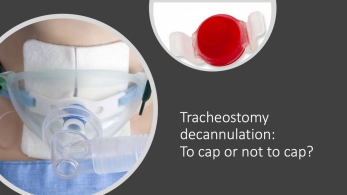#EMConf: What is the Role of TXA in a GI Bleed?
There has been very compelling literature suggesting TXA could be useful in the setting of an acute bleed.
There has been very compelling literature suggesting TXA could be useful in the setting of an acute bleed.
Its 3am in the ED and you need to call a consult. What strategies can you use to get great care for your patients and be a good colleague?
Does giving bicarbonate during cardiac arrest increase return of spontaneous circulation (ROSC) and good neurological function upon discharge?

A 49-year-old woman was intubated for acute hypoxemic respiratory failure secondary to pneumonia, which was complicated by empyema. She failed extubation and ultimately required tracheostomy for prolonged mechanical ventilation. After transfer to the intermediate care unit, she was successfully weaned from the ventilator for over 24 hours. She tolerated prolonged deflation of her tracheostomy cuff and swallowed water without aspiration. She underwent a tracheostomy tube occlusion test and there was no obstruction to air flow with a size 7 fenestrated tracheostomy tube in place. She is requiring suctioning once every 12 hours. You are assessing her readiness for tracheostomy decannulation and are considering the utility of a capping trial.
With several anticoagulants now on the market, one needs to be well versed in the various reversal options in the setting of lifethreatening bleed (or if supratherapeutic on coumadin). Here's your quick review.
It’s a familiar call ahead to the ED - an adult patient who is febrile, hypotensive, with suspicion towards infection. While setting up the room, the patient’s bedside nursing team asks if you’d like them to get saline or lactated Ringer’s (LR) ready for resuscitation. You wonder if there’s any new evidence examining the use of saline versus balanced crystalloids in the emergency department.
An 87 yo male is brought in by EMS after a syncopal event while on the toilet, resulting in a fall and head injury. EMS reports a heart rate in the 30s en route. As your approach the resuscitation bay you begin to think about the causes of bradycardia and what your approach will be to stabilize this potentially very sick patient....
Hypoglycemia can be a lifethreatening emergency - here's your quick review of s/sx, causes and management.

A 52-year-old woman with a history of hypertension sustained a large left frontoparietal intracerebral hemorrhage resulting in right-sided flaccid paralysis complicated by acute respiratory failure status post tracheostomy for prolonged mechanical ventilation. She is transferred to the step-down intensive care unit for ventilator weaning. Serum calcium level returns elevated at 11.3 mg/dL with a serum albumin level of 2.8 g/dL. What is the most likely cause of her hypercalcemia and how should it be managed?
It's a typical day in the ED. You are asked to see your next patient who is a 60 year old male, recently discharged from the hospital after being treated for cellulitis presenting with abdominal pain and diarrhea. He’s tachycardic and hypotensive to 75/40. The patient is mentating well. After taking a more thorough history your differential diagnosis narrows in on intra-abdominal sepsis associated with significant volume losses. The lactate returns at 6. On volume assessment by physical exam and POCUS, the patient is significantly volume down. You know that getting the antibiotics and fluids on board is the cornerstone of treatment, but they will take some time to be given. You wonder if you should temporize your resuscitation with pressors during the time it takes for the fluids and antibiotics to be administered.
Copyright © 2024,
Designed by Zymphonies
